At the dawn of India’s Independence in 1947, the subcontinent was marked by the tumultuous events of Partition, violence, and widespread communal riots. Amidst this chaotic backdrop, the future of over 500 princely states posed a significant challenge. During British rule, these princely states enjoyed limited autonomy under the suzerainty of the British Crown, maintaining their regal ceremonies and a semblance of power. However, as India prepared to step into the modern era as a free nation, these princely states were viewed by the Indian political elite as an anachronism that conflicted with the vision of a unified and democratic India.

The Historical Context of Princely States
Princely states were semi-autonomous regions ruled by local monarchs who had entered into subsidiary alliances with the British. These rulers, while maintaining internal sovereignty, ceded control of their external affairs, defense, and communications to the British. The arrangement allowed them to preserve their traditional roles, and they often continued to revel in the grandeur and ceremonial splendor of their royal courts.
However, the independence movement, spearheaded by leaders like Mahatma Gandhi and Jawaharlal Nehru, envisioned a united India free from the vestiges of feudalism and colonialism. As the British prepared to leave, the question of integrating these princely states into the new Indian Union became a priority.
The Challenge of Integration
The process of integration was neither straightforward nor devoid of tension. The Indian Independence Act of 1947 gave princely states the option to join either India or Pakistan or to remain independent. This created a complex and potentially explosive situation. Many princely states were geographically contiguous with India and culturally aligned with its diverse tapestry, but the idea of giving up their sovereignty was unpalatable to many rulers.
The Indian leadership, particularly Sardar Vallabhbhai Patel and V.P. Menon, undertook the arduous task of negotiating with the princely states. Through a combination of diplomacy, persuasion, and occasionally coercion, they managed to bring the majority of these states into the Indian Union. This effort was crucial in ensuring the territorial integrity and political unity of India.
The Unique Case of Kashi (Varanasi)
Amidst the broader context of integration, certain princely states presented unique cases that highlighted the complexities involved. One such case was that of Kashi (now Varanasi), a city of immense religious significance to Hindus. In August 1949, Vibhuti Narain Singh, the Maharaja of Benares, also known as Kashi Naresh, wrote to C. Rajagopalachari, the Governor-General of independent India, with a remarkable proposition.
The Maharaja advocated for Kashi to be declared a “free city like the Vatican City,” with himself occupying a role analogous to that of the Pope. This proposal was intriguing for several reasons. Firstly, it highlighted the deep-seated religious and cultural significance of Kashi, often referred to as the spiritual capital of India. Secondly, it demonstrated the Maharaja’s attempt to retain a semblance of his traditional authority in a radically changing political landscape.
The Imagery of the Vatican City
The imagery of the Vatican City, the independent city-state and spiritual center of the Roman Catholic Church, was a strategic and symbolic choice. By invoking this comparison, the Maharaja sought to position Kashi as a center of spiritual authority and autonomy within India. This was a bid to maintain his status and influence in a city that had been a historical seat of Hindu pilgrimage and learning.

While the proposal did not materialize, it underscored the diverse and complex challenges faced by the nascent Indian state in integrating princely territories. The Indian leadership, committed to building a secular and democratic nation, could not afford to allow any form of sovereign exception that might undermine the integrity of the Indian Union.
Conclusion
The integration of princely states into independent India was a monumental task that required a delicate balance of diplomacy, pragmatism, and, at times, strategic force. The case of Kashi and the proposal by the Maharaja of Benares serves as a fascinating example of the cultural and political negotiations that were an integral part of this process. As India emerged as a unified nation, the successful integration of these states laid the foundation for the political stability and territorial unity that would define the republic in the years to come.











